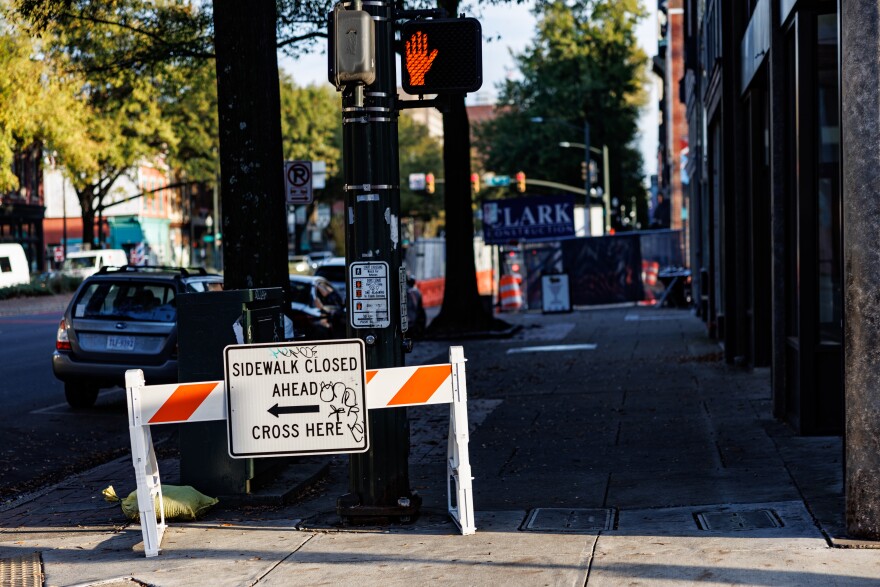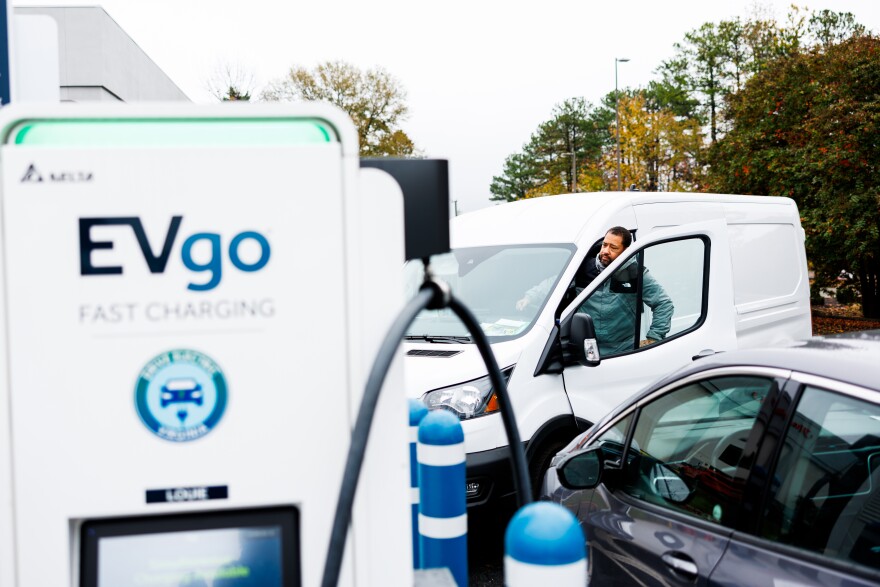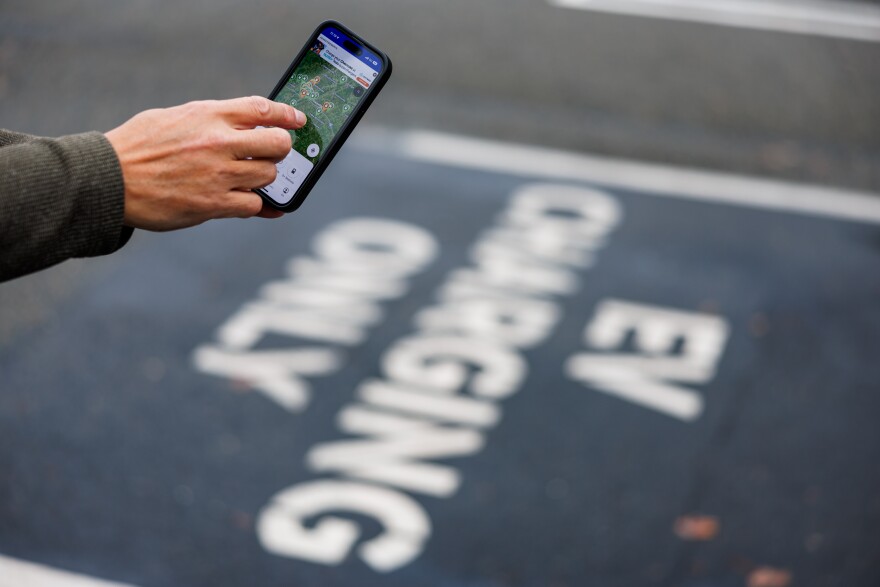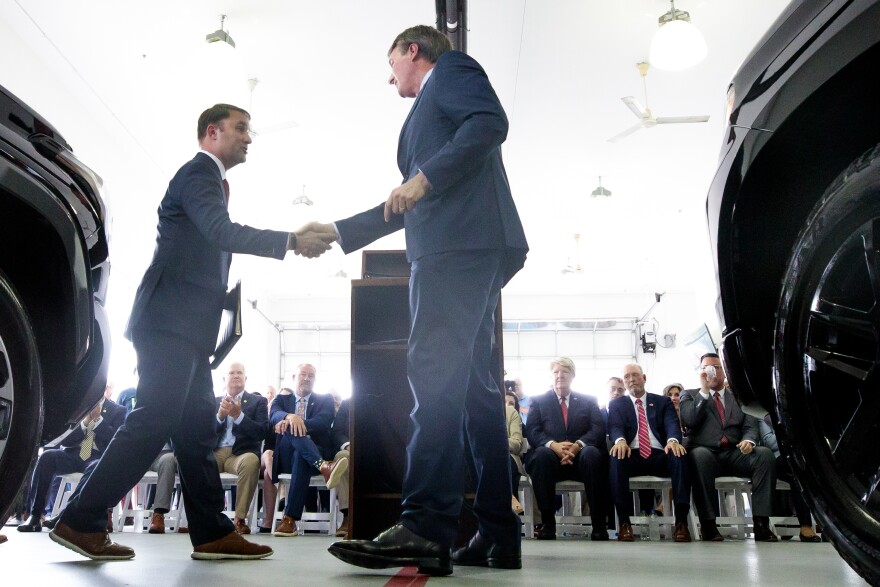Curious Commonwealth takes our audience’s questions, dives down the rabbit hole and brings back the stories of Virginia’s people and places to tell.
This year, we tackled the history of Richmond’s tattoo artistry, why Virginia’s cities and counties are so different from nearly everywhere else in the US, the invasive tree of heaven plant, why Three Chopt Road looks the way it does and how non-employer retirement distributions work in the commonwealth.
As 2024 ends, VPM News decided to answer a couple lingering questions at once — we’re calling it A Little Bit Curious.
Why doesn’t Richmond require protected pedestrian access during construction?
In Richmond, it’s common to see downtown construction projects shut down whole city blocks where pedestrians are compelled to cross the street, pause a run or otherwise disrupt their commutes. And those blockades can last years.
Richmond resident Paul Brockwell took notice.
“I have a specific question about Richmond and why the city does not require construction companies to protect pedestrian access to sidewalks during major projects,” asked Brockwell, who used to sit on VPM’s Community Advisory Board and Young Professional Advisory Board. “This happens all the time in [New York], and there are proven ways of allowing access with protective scaffolding vs. yearslong closures of sidewalks that drive walkers into vehicle lanes.”
VPM’s construction of its new headquarters in historic Monroe Ward actually prompted Brockwell’s question. He was walking in Jackson Ward one night over the summer — getting tacos with friends — when he noticed the construction site spills over the sidewalks on East Broad Street to the north and East Grace Street to the south, obstructing the pedestrian right of way.
Brockwell called the setup a recipe for disaster.
“We’re walking in the street. Our back is facing oncoming traffic. It’s after dark,” he said.
But it’s a familiar sight in Richmond (not picking on you, VPM). Virginia Commonwealth University recently closed sidewalks on North Belvidere and West Broad streets (just west of VPM’s upcoming headquarters) through 2027. Axios Richmond reported using state Department of Transportation crash data that the intersection at West Grace and North Belvidere streets is one of the worst for crashes involving pedestrians.
And the Richmond Times-Dispatch reported in October that the Richmond area averages 21 pedestrian deaths per year. Experts say it’s a lack of adequate pedestrian infrastructure (especially in low-income areas) and distracted driving to blame.
“I see it all over Richmond,” Brockwell said. “No one is required to protect pedestrians' right of way on sidewalks.”
Protecting sidewalks is just a piece of a much larger transportation safety puzzle. It’s less frequent in Richmond, than in places like New York City, said Joseph Davenport, chief of construction and inspection with the city’s Department of Public Works.
“[B]ut we do employ the covered walkways, adjacent to work zones,” said
Davenport offered a few examples, including 800 W Franklin St. and 15 W 7th St. in Old Town Manchester. Both projects, he said, lend themselves to covered walkways.
“What you have in Richmond and the downtown area that’s a little bit different than maybe New York City — where you might see the covered walkways much more frequently — is New York City has a built high-rise urban design,” Davenport said. “Their projects are, by a large majority, interior renovations: a gut rehab keeping the structure in place.”

According to Davenport, Richmond is a low-rise urban setting where there are mostly two and three- story buildings. Many developers are demolishing existing structures entirely and rebuilding taller buildings.
“You’ve got a deep excavation,” he said. “You’re building at the lot line, so to facilitate the construction activities you’ve got to have space around the work zone. That winds up being the sidewalk area that becomes part of the work zone.”
What tends to happen in Richmond to maintain the flow of foot traffic, is a construction company cordons off a pathway adjacent to the work zone or erects signs notifying pedestrians of a detour.
The city’s work zone policy requires companies to submit a plan to DPW for work in streets and on sidewalks when applying for a construction permit. It does not specify what methods must be used to make way for pedestrians and cyclists.
But outgoing City Councilor Andreas Addison, who represents the 1st District, says it should. In 2020, he introduced a resolution to protect walkways and bicycle lanes during construction.
“I was told I can only ask that they please do it whenever there's a project,” Addison recently told VPM News. “So my legislation that I put in there gives them all the wiggle room they want to not do it.”
Still, Addison said it’s the responsible thing to do.
“Is there a cost? Is there a burden? Yes. Is it what every other city in the country does?” he asked. “Absolutely. Why not us?”
In 2018, the City of Alexandria stopped approving Maintenance of Traffic plans that diverted pedestrians and cyclists to alternate routes. It sent a memo to developers, architects, surveyors and engineers announcing that protected access within the public right-of-way must be maintained. That meant plans had to either minimize the construction area or erect covered walkways.
That’s something Brockwell can get behind.
“To me, it’s incumbent on the city if they’re really serious about achieving a safer city for pedestrians and zero traffic fatalities to bake this into the design of the permitting process,” Brockwell said.
VPM News asked VPM Media Corp. for comment on Brockwell’s concerns. Our FCC license holder provided this statement in response:
VPM and our construction partner Clark Construction must comply with all of the City of Richmond's requirements to ensure the safety of pedestrians and the crews working on the project site. The restricted pedestrian access is necessary to maintain accessibility and safety throughout this phase of construction. Where opportunities arise to minimize inconvenience to neighbors, we remain open to discussions with the City to explore possible adjustments.
Disclosure: VPM Media Corp. is the FCC license holder of VPM News, which operates as 88.9 FM in Richmond, 89.1 FM in the Northern Neck (Heathsville) and 90.1 FM in Southside Virginia (Chase City).
As a newsroom, VPM News maintains editorial independence — this article went through our usual fact-checking and editing process. Station leadership did not know interview questions ahead of time, and they did not view this article prior to publication.
Questions about this article and VPM News’ overall editorial policy should be directed to Managing Editor Dawnthea M. Price Lisco and News Director Elliott Robinson.

Why can’t I buy a plug-in hybrid vehicle in Virginia?
Dr. George Spagna, a retired Associate Professor of Physics at Randolph-Macon College asked this question.
Spagna said while visiting a Honda dealer a couple of years back in search of a plug-in hybrid, a salesperson told him he couldn’t buy one in the commonwealth.
“He said I can sell you a hybrid. I can sell you an electric. But I can’t sell you a plug-in,” Spagna told VPM News. “So I did a little online research and got something slightly garbled that said some states have pollution regulations, or something of that line, that makes it unprofitable for the dealers to sell those so manufacturers don’t sell them in Virginia. The guy said, ‘You can go to Maryland. You can go to South Carolina. You can have one here. You can license it here. But you can’t buy one.’”

A quick Google search shows there are plenty of plug-in hybrids for sale in Virginia.
“I looked on cars.com, and there was like over 100 electric vehicles within a 30 mile radius of Richmond,” said Charles Gerena, the lead organizer for Drive Electric RVA, a Central Virginia organization that promotes electric vehicles. “And with a good chunk of those being plug-in hybrids.”
Just outside Target off of Midlothian Turnpike, Gerena is hanging out talking to other EV owners.
“Those states that have the clean car standards tend to get more models from automakers,” Gerena said. “Because they figure, ‘Well if it’s required in that state,’ then they’re going to sell more. So they put them there.”
The sale of electric vehicles in Virginia increased by 49% from 2022 to 2023 — which coincides with Virginia's adoption in 2021 of California's low-emission vehicle and zero-emission vehicle standards. Virginia mandated that starting in 2024, all new vehicles sold in Virginia be electric by 2035.
According to the International Council on Clean Transportation, there is a direct connection between states that adopt the California standards and the availability of EV models.
Gov. Glenn Youngkin announced in June that Virginia will exit that mandate at the end of Year.

Gerena said even before Virginia adopted the clean car standards, some local dealerships jumped on the EV market to great success.
“There’s certain dealerships that tend to get all the EVs, because they tend to do very well selling them,” Gerena said. “So that might be one reason why you might not be able to find the model or the particular EV that you’re looking for — because they may all be clustered at a handful of the dealerships that tend to be the big EV sellers.”
Spagna said he ultimately decided to pay off the solar panels on his house before buying an EV, but he’s still interested in a plug-in hybrid.
“Strictly electric would not work for us. One of my daughters lives in Vermont. And if we were to take a road trip to go to Vermont, I wouldn’t want to have to set the route based on where I could charge the vehicle,” Spagna said. “A plug-in hybrid makes sense. I can plug it in at home and basically drive on the battery for local runs and then, taking a road trip for 10 hours, if we couldn’t find a quick charger, put gas in it and keep going.”
This story was produced as part of the VPM News series Curious Commonwealth.



